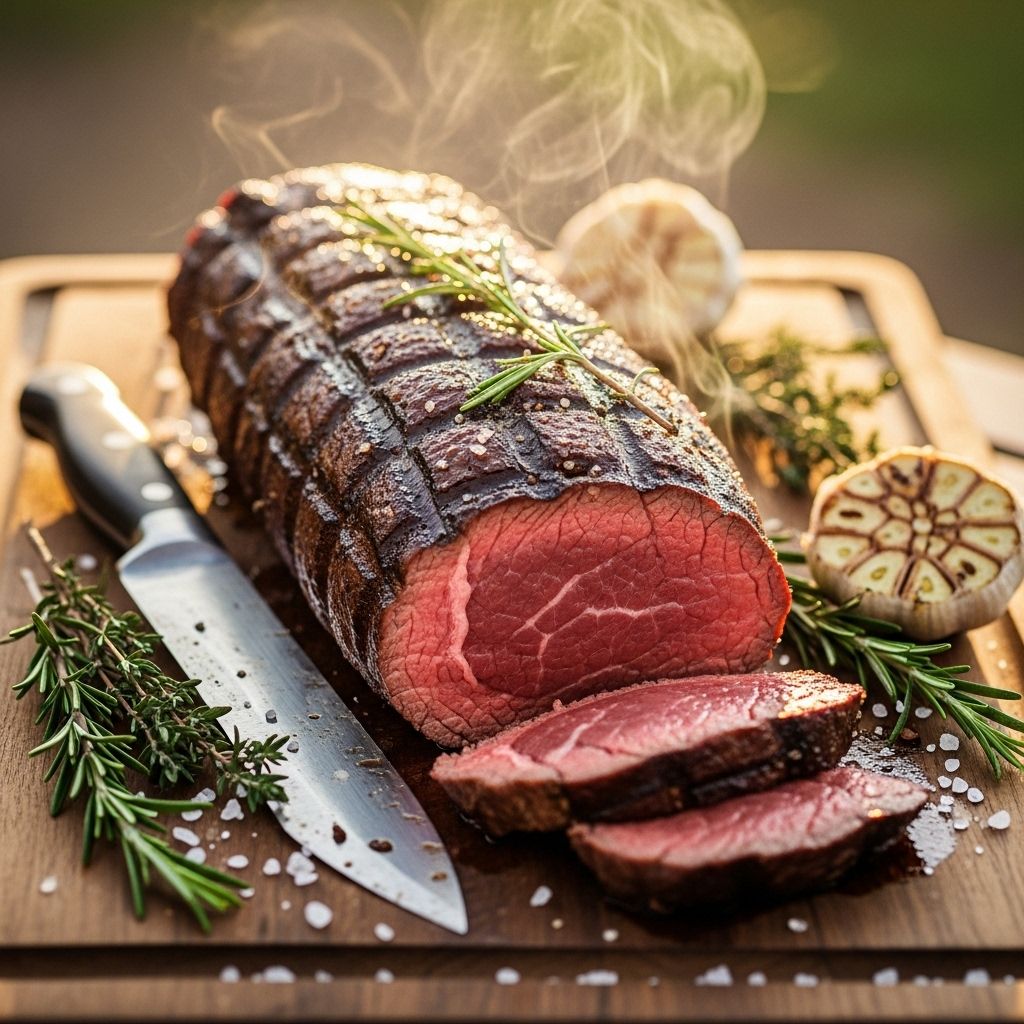How To Grill-Roast A Whole Beef Tenderloin: Comprehensive Guide
Precision trimming and seasoning yield tender, flavorful slices that steal the show.

How to Grill-Roast a Whole Beef Tenderloin
If you want to cook a showstopping centerpiece for a special occasion, nothing rivals the impressive whole beef tenderloin. Known for its buttery texture and unparalleled tenderness, a whole beef tenderloin on the grill is the ultimate crowd pleaser. However, this prized cut demands careful preparation, correct technique, and precise grilling to guarantee success. This comprehensive guide offers everything you need to know—from selecting and trimming the meat all the way through perfect grilling and expert carving.
Table of Contents
- Why Grill-Roast a Beef Tenderloin?
- Choosing, Trimming, and Tying the Tenderloin
- Seasoning Strategies
- Setting Up the Grill
- Grill-Roasting Technique
- Temperature and Doneness Guide
- Resting and Carving
- Serving Suggestions & Sauces
- Frequently Asked Questions
Why Grill-Roast a Beef Tenderloin?
Beef tenderloin is the gold standard for tenderness and flavor among all beef cuts. It’s naturally lean yet exceptionally tender, making it an ideal candidate for grill-roasting, which imparts a beautiful smoky flavor and a perfectly caramelized crust. Cooking it whole preserves its juiciness and yields a dramatic, restaurant-quality presentation perfect for holidays, celebrations, or whenever you want to impress.
Choosing, Trimming, and Tying the Tenderloin
Proper preparation is crucial for grill-roasting success. Here’s what to keep in mind:
- Selection: Look for a whole beef tenderloin (sometimes labeled “PSMO” for “peeled side muscle on”) weighing around 5–6 pounds. It will have a thin tapered end (the “tail”), a thick center, and the smaller “head” or butt. Ask your butcher for a “center-cut” tenderloin to ensure more even cooking.
- Trimming: Remove excess fat, especially the silverskin—a thin, shiny membrane that doesn’t break down during cooking. Use a sharp boning knife, working with short strokes, to gently slide under the silverskin and remove it completely without gouging the meat. Also consider trimming off the “chain” (a thin strip of muscle running along one side).
- Tying: Tying the tenderloin with butcher’s twine at 1–2 inch intervals helps it hold a cylinder shape, allowing for even cooking. Fold the thin tail section underneath itself and tie it securely so the roast is uniform in thickness.
Visual Guide: Trimming & Tying
- Step 1: Lay the tenderloin on a large cutting board.
- Step 2: Trim off all silverskin and excess fat with a sharp knife.
- Step 3: Remove the chain muscle (if desired) and save for stir-fry or mince.
- Step 4: Fold the tail underneath for even thickness.
- Step 5: Tie with butcher’s twine every 1–2 inches along the entire length.
Seasoning Strategies
Because beef tenderloin is subtly flavored and tender, bold seasoning works wonders. Classic approaches include:
- Salt: Kosher salt applied generously all over the roast helps draw out surface moisture and enhances flavor.
- Pepper: Freshly ground black pepper adds aroma, heat, and complements the crust.
- Optional Extras: Olive oil, garlic, finely chopped rosemary or thyme, and cracked coriander seeds can be rubbed over the surface for extra fragrance. Consider applying the salt at least 1 hour ahead to allow it to penetrate deeply.
Setting Up the Grill
The key to grill-roasting tenderloin is using two-zone indirect heat—a hot side and a cooler side. This setup lets you first sear the meat for a crust, then gently roast it through without burning.
- Light a full chimney of charcoal, let it ash over, and carefully pour the coals onto one side of the grill.
- Place the cooking grate, cover, and allow it to preheat fully—about 5 minutes.
- Clean and oil grate before cooking to prevent sticking.
Grill-Roasting Technique: Searing and Indirect Cooking
Follow these steps for flawless results:
- Room Temperature: Remove tenderloin from fridge and let sit while grill heats up. This promotes even cooking.
- Sear: Brush the beef all over with oil. Place on hottest part of grill, directly above coals. Sear each side for 2–3 minutes until well browned (usually 4 sides).
- Indirect Roast: Move the tenderloin to the cooler side. Cover the grill and roast, turning halfway through. Monitor internal temperature closely.
- Monitor: Use an instant-read thermometer to check doneness. Target is 120°F for rare, 125°F for medium-rare.
| Doneness | Pull-off Temp | Final Temp* | Description |
|---|---|---|---|
| Rare | 120°F (49°C) | 125°F (52°C) | Deep red center, very juicy |
| Medium-Rare | 125°F (52°C) | 130°F (54°C) | Bright pink center, tender & juicy |
| Medium | 135°F (57°C) | 140°F (60°C) | Light pink center, firmer texture |
| Well Done | 145°F (63°C) + | 150°F (66°C) + | Brown throughout, less juicy |
*Remember: Carryover cooking can raise the internal temp by another 5°F after removing from the grill.
Temperature and Doneness Guide
Rare or medium-rare maximizes tenderness and juiciness. Remove at 120–125°F; after a brief rest, the meat should reach 125–130°F. Use an instant-read thermometer. Don’t guess!
Resting and Carving
- Resting: Let the roasted tenderloin rest on a cutting board, loosely tented with foil, for 10–15 minutes. This allows juices to redistribute so every slice is succulent.
- Carving: Remove twine, then slice across the grain into 1/2 to 1-inch thick medallions. Use a sharp carving knife for clean cuts.
Serving Suggestions & Perfect Sauces
Grill-roasted tenderloin is stunning on its own, but it pairs beautifully with a range of sides and sauces. Classics include:
- Red Wine Reduction: Simmer beef stock and red wine with shallots & herbs; reduce till syrupy.
- Béarnaise Sauce: A rich, tarragon-infused French classic for silky pairing.
- Horseradish Cream: Mix sour cream with prepared horseradish and chives for zest.
- Roasted Vegetables: Potatoes, carrots, broccolini, grilled asparagus—all pair beautifully.
Slice and arrange the beef on a warmed platter, serve with sauces on the side, and finish with flaky sea salt.
Frequently Asked Questions (FAQs)
Q: Can I grill-roast a whole beef tenderloin on a gas grill?
A: Yes, use one side on high heat for searing, then move to the cooler side for indirect roasting. Monitor temperature as you would with charcoal.
Q: Do I need to marinate the tenderloin?
A: Marinating is optional. Because tenderloin is naturally tender, seasoning with salt, pepper, and herbs is usually enough to enhance flavor.
Q: How do I prevent overcooking?
A: Watch the internal temperature carefully and pull the roast once it reaches your desired doneness. Remember, carryover cooking will raise the internal temp by 5°F or more.
Q: How do I reheat leftovers without drying out the beef?
A: Gently reheat slices in a low oven (around 250°F) with some beef broth or steak drippings to retain moisture.
Expert Tips for Perfect Beef Tenderloin
- Bring meat to room temperature before grilling for even cooking.
- Use butcher’s twine to maintain a uniform shape.
- Season at least 1 hour in advance for deeper flavor.
- Sear over high heat, then finish over indirect heat for best crust & tenderness.
- Always rest before carving to preserve juices.
- Slice across the grain for maximum tenderness per bite.
Troubleshooting & Common Mistakes
- Dry Beef: Usually from overcooking or slicing too soon. Always monitor temperature and let rest.
- Uneven Cooking: Failure to fold/tuck thinner end or skipping the tying step.
- No Crust: Grill wasn’t hot enough during searing—ensure full preheat.
- Sticking: Oil the grate before searing.
Variations & Flavor Twists
- Herb-Crusted: Coat exterior with finely chopped parsley, rosemary, thyme prior to grilling.
- Peppercorn-Crusted: Press crushed black peppercorns onto the surface for extra bite.
- Mustard-Rub: Combine Dijon with olive oil and rub over meat before seasoning.
- Smoked Tenderloin: Add a handful of wood chips to the coals for a subtle smoky aroma.
Recap: Step-by-Step
- Trim and tie tenderloin for even cooking.
- Season generously and let rest at room temp.
- Preheat grill to high; set up for two-zone cooking.
- Sear all sides over hot coals, then move to cooler side.
- Roast covered, using thermometer to check doneness.
- Rest, slice, and serve with your favorite sauces.
Conclusion: The Perfect Grilled Beef Tenderloin
Grill-roasting a whole beef tenderloin is more straightforward than you might think, but attention to detail makes all the difference. With careful trimming, thoughtful seasoning, precise grilling, and proper resting, you’ll produce a centerpiece worthy of the finest steakhouse—smoky, rich, and loaded with flavor. Next celebration, give this technique a try and enjoy the accolades!
Read full bio of Srija Burman












